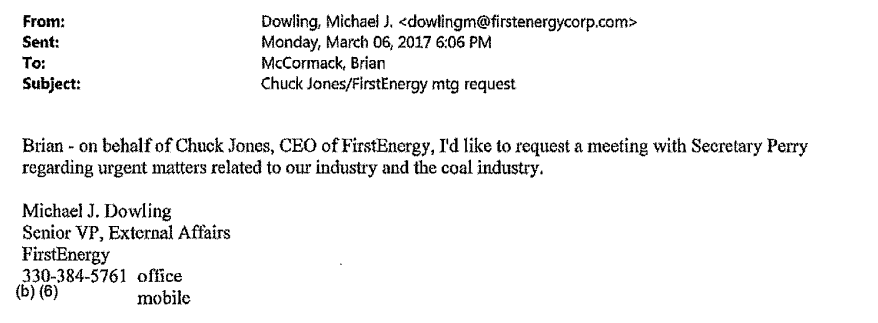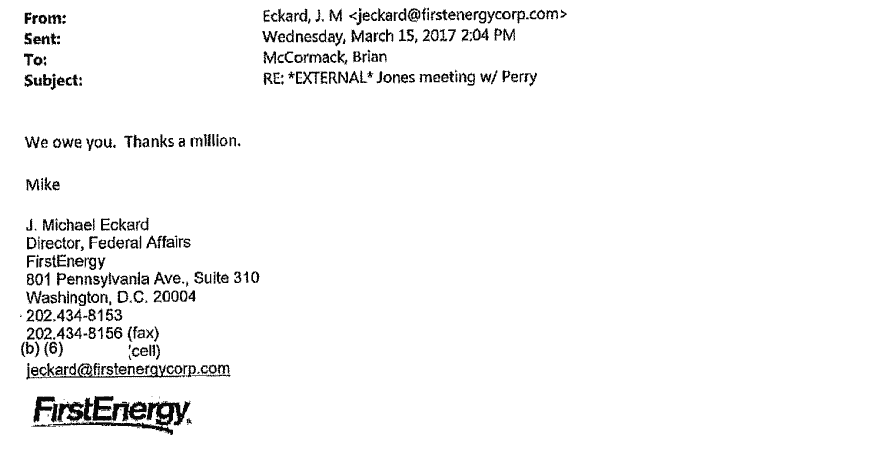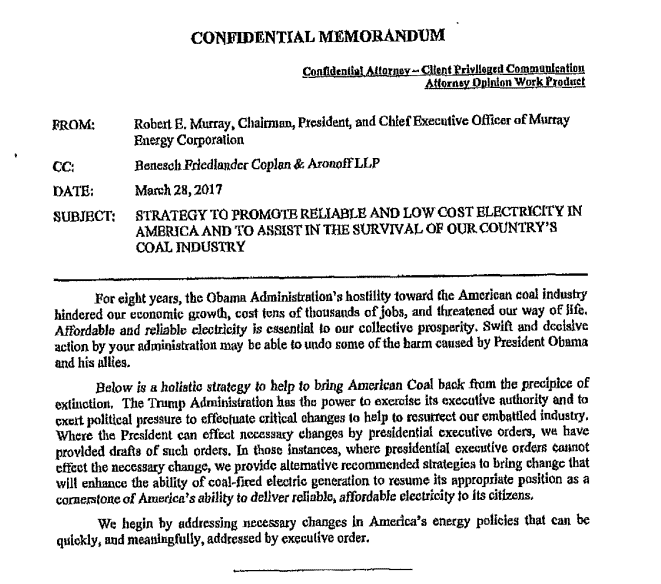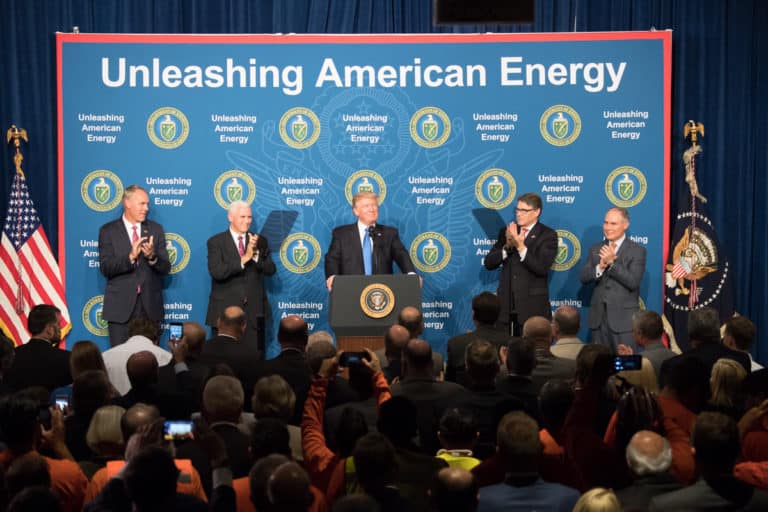New details about FirstEnergy’s lobbying of the Trump administration and corporate airplane flights to Washington, D.C., can be found in documents obtained via FOIAs filed with the Department of Energy and Federal Aviation Administration by the Energy and Policy Institute.
Documents released by the Department of Energy (DOE) on June 8, 2018 reveal that Charles E. Jones, the CEO of FirstEnergy Corporation, was scheduled to meet with Secretary of Energy Rick Perry on the morning of March 15, 2017. FirstEnergy Corp. has neither confirmed or denied that the meeting took place, but the timing of a thank you note sent on the afternoon of March 15 suggests that the meeting did occur.
Analysis of flight data obtained by the Energy and Policy Institute (EPI) also shows a sharp increase in the number of flights to D.C. made by two corporate airplanes owned by now-bankrupt FirstEnergy subsidiaries since the week of President Trump’s inauguration. The two FirstEnergy aircraft traveled to the nation’s capital just four times in 2016, but made thirty-one trips to D.C. between January 17, 2017, and April 3, 2018.
The flight data was obtained through a FOIA request EPI filed with the Federal Aviation Administration.
The documents released by DOE also made public for the first time a 17-page “Confidential Memorandum” from Robert E. Murray, the CEO of coal producer Murray Energy. The memo appears to be the work of Benesch Friedlander Coplan & Aranoff, a law firm known for its efforts to fight the closure of coal-fired power plants, and oppose new wind farms and natural gas power plants in Ohio. It represents a more detailed version of Murray Energy’s four-page Action Plan for the Trump administration, which was first made public in January 2018 by the New York Times.
DOE released the documents to the EPI after months of delays, and only after persistent efforts by Earthjustice staff attorney Kim Smaczniak, who assisted in securing the documents. The same documents were released to reporters at E&E News, who broke the news, and the advocacy group Public Citizen.
FirstEnergy’s meeting with Rick Perry was arranged by Brian McCormack, a former VP of external affairs for the Edison Electric Institute
FirstEnergy Corporation contributed a total of $1,259,902.50 to the Cleveland 2016 Host Committee Inc., which placed it among the top ten donors to the committee that organized the 2016 Republican Convention. Several payments for “Hotel rooms” were made at the start of the Republican Convention.
As highlighted above, newly released emails from DOE reveal that FirstEnergy Corp. CEO Chuck Jones was scheduled to meet with Secretary of Energy Rick Perry on the morning of March 15, 2017.
“Brian – on behalf of Chuck Jones, CEO of FirstEnergy, I’d like to request a meeting with Secretary Perry regarding urgent matters related to our industry and the coal industry,” Michael J. Dowling, senior VP of external affairs wrote in a March 6 email to Brian McCormack, Secretary Perry’s chief of staff.

Prior to joining the Trump administration, McCormack was the vice president of external affairs for the Edison Electric Institute, the powerful industry association for investor-owned electric utilities. Jones served as one of EEI’s board leads on the topic of “Wholesale Market Issues – Impact on Baseload Generation” during EEI’s September 2016 Board & Chief Executives Meeting.
The EEI meeting took place at The Broadmoor luxury resort in Colorado Springs about two months before Donald Trump’s election, and Jones’s session raised issues that in retrospect are remarkably similar to those that the Trump administration would later use as an excuse to try to bailout coal and nuclear power plants:
While RTO and ISO markets have been operating for over 20 years, a number of organic and external factors are changing the generation mix as well as the services needed to maintain reliability. These include low natural gas prices, increasing use of behind-the meter, storage and renewable resources as well as state and federal public policy goals. These changes have led to questions about whether the wholesale markets are able to retain needed generation and whether the energy and ancillary services market signals reflect the true cost of operating the system. Premature retirements of baseload generation due to inability to recover costs have fueled these discussions.
The night before FirstEnergy’s March 15, 2017, meeting with Rick Perry, McCormack sent an email about a potential scheduling conflict, but then later followed up to confirm the meeting was still on as scheduled.
“Looks like we’re ok,” McCormack said in his email. “But if you can be 10 mins early that would help. He has to skip the EEI meeting. I had to alert them a short time ago.”
“We owe you. Thanks a million,” J. Michael Eckard, director of federal affairs for FirstEnergy, responded to McCormack at 2:47 pm in the afternoon on March 15, after the meeting was scheduled to take place.

The Energy and Policy Institute asked FirstEnergy Corp. to confirm that the March 2017 meeting with the Department of Energy took place.
“FirstEnergy has long believed that coal and nuclear power plants are critical to a strong, resilient electric system,” said a response from Jennifer Young, lead on generation and environmental communications for FirstEnergy Corp.
“We have previously acknowledged that we’ve discussed our thoughts on preserving baseload coal and nuclear generation with federal officials in the Department of Energy and White House,” according to Young.
“I don’t have that specific information,” Young said when asked specifically if Jones met with Perry in March of 2017.
“I don’t think the DOE initiative has anything to do with FirstEnergy, despite what’s been reported in some of the media,” Jones himself said in November of 2017, after Perry proposed a controversial bailout for coal and nuclear power plants that would have benefited FirstEnergy.
After Perry’s proposal was rejected by the Federal Energy Regulatory Commission, the now bankrupt subsidiary FirstEnergy Solutions filed a petition that called on Perry to use DOE’s authority under Section 202(c) of the Federal Power Act to bailout coal and nuclear power plants.
Since then, Jones has changed his tune, saying on FirstEnergy Corp.’s Q1 2018 earnings call:
… I will continue personally to advocate for regulatory or legislative solutions, including FES’ application for an emergency order under the Federal Power Act that recognize the attributes of fuel secure baseload generation and to ensure our customers continue to have a stable, reliable power supply.
FirstEnergy corporate airplanes have flown to D.C. thirty-one times since the week of Trump’s inauguration, and some of those trips overlap with key energy policy events
EPI’s analysis of FAA flight data shows the number of flights to Washington, D.C. by the two corporate airplanes owned by the now-bankrupt FirstEnergy Solutions and FirstEnergy Aircraft Leading Corp. increased from just four flights in 2016 to twenty-four in 2017. FirstEnergy’s first flight to D.C. in 2017 was made on January 17, the week of President Trump’s inauguration.
The two FirstEnergy planes also logged seven flights to D.C. in 2018 by April 3, the last date included in the FAA flight data obtained by EPI. All told, the FirstEnergy airplanes made 31 flights to D.C. between January 17, 2017, and April 3, 2018.
As previously reported, Republican Larry Householder – a top contender for speaker of the Ohio House in 2019 – flew with his sons to Trump’s inauguration on board one of FirstEnergy’s planes. Householder later co-sponsored a bill to bail out FirstEnergy’s nuclear power plants in Ohio, which are now slated to be decommissioned, and he’s received campaign cash from the utility too.
Some of FirstEnergy’s other flights to D.C. overlapped with key moments in the Trump administration’s efforts to bail out the coal and nuclear industries, as well as other noteworthy policy events.
One of FirstEnergy’s planes arrived in D.C. on the morning of Chuck Jones’s March 15, 2017, meeting with Rick Perry, and departed back to Akron, Ohio that afternoon. Akron is home to FirstEnergy’s corporate headquarters. The same plane also flew from Akron to D.C. and back just a few days earlier, on March 13, 2017.
Another flight arrived in D.C. on April 13, one day before Perry’s controversial memo ordering a “study examining electricity markets and reliability” on April 14. At the time, the memo was widely viewed as setting the stage for a bailout of Trump’s political allies in the coal and nuclear industries, and a thinly-veiled attack on renewable energy and clean energy policies.
Two weeks later, on April 28, Jones said during a quarterly earnings call with investors (emphasis added):
… here’s what I’m going to say about that DOE initiative. And obviously, since it came out, we’ve had a lot of discussions. And I have personally been down in D.C. and talked to people both at DOE and in the administration. To put a 60-day time on completing this is very aggressive. I think they view it as something that needs to be very aggressive because there are more and more closures of these fuel-secure baseload assets being announced all the time. So I think the administration is serious about this. Our Washington team tells me that this is a very serious initiative. I don’t think we’re in any position right now to handicap what they might do at the end of this study. But if their intention is to keep these fuel-secure baseload assets from closing, then they’re going to have to do something to make sure that there’s a financial incentive for these plants to not close. So I think it’s prudent for us to let them do their work. It’s clear DOE is focused on this. The Secretary was speaking at a Bloomberg conference earlier this week and talked about it there and the importance of this, and I’m sure this also clearly ties into one of the President’s key initiatives, which is to protect our coal natural resource and the mining and jobs that go along with that. So I think it would be — it’s just prudent for us to see where that goes.
A FirstEnergy plane later flew from Akron to D.C. on June 19, and then back to Akron the next day.
“Dozens of power industry executives who flew to Washington for a Monday meeting with U.S. EPA Administrator Scott Pruitt had three minutes apiece to tell him whether they want to replace the Clean Power Plan,” on June 19, according to E&E News.
FirstEnergy Corp. later filed comments supporting Scott Pruitt’s proposal to repeal the Clean Power Plan, which established the first-ever limits on carbon dioxide emissions from power plants.
“The Clean Air Act was not designed to effectively regulate GHGs, so we caution EPA to be careful in using an inappropriate tool where the results of doing so often come with negative consequences,” FirstEnergy Corp. said in its comments to the EPA.
Trump spoke at an “Unleashing American Energy” event at DOE on June 29, and a FirstEnergy plane flew from Akron to D.C. and back that same day.
President Trump met with Chuck Jones on August 3 in Huntington, WV, according to a letter from Bob Murray dated the following day. One of FirstEnergy’s planes arrived in Huntington on August 3. It then flew to Lewiston, WV, and Washington, D.C., before returning to Akron.
“We have requested that President Trump direct Energy Secretary Rick Perry to invoke Section 202(c) of the Federal Power Act declaring an emergency on the electric power grid,” Murray wrote in his August 4 letter to John McEntee, special assistant and personal aide to the President.
“FirstEnergy is on the verge of bankruptcy, as we advised President Trump in the oval office four weeks ago, in Youngstown nine days ago, as well as last evening,” Murray also said in the letter.
One month earlier, on July 4, a FirstEnergy plan flew from Akron to D.C., and then returned to Akron the next day.

The letter from Murray was previously made public by the Associated Press.
Perry sent a letter and Notice of Proposed Rulemaking (NOPR), both dated September 28, to FERC. A FirstEnergy plane arrived in D.C. one day before, on September 27, and departed on the 28th. Perry’s proposal amounted to bail out for coal and nuclear power plants that would have primarily benefit Murray Energy and FirstEnergy.
Local officials from Ohio met with Neil Chatterjee, then Trump’s interim chairman of FERC, in D.C. on November 28 to discuss the future of FirstEnergy’s Perry and Davis-Besse nuclear power plants. A FirstEnergy plane arrived in D.C. from Akron that same day, and flew back to Akron on the 29th.
Ed Kclo, the mayor of North Perry, was part of the contingent. Kclo has met with FirstEnergy on a monthly basis, according to the minutes from a May 18, 2017, North Perry Village Council work session.
One of FirstEnergy’s plane was back in D.C. on December 14, not long after Perry announced a 30-day extension of his deadline for FERC to reach a decision on his coal and nuclear bailout proposal. Another flight landed in D.C. on January 4, a few days before FERC announced its decision to reject Perry’s proposal.
On February 8, 2018, Bloomberg reported that the Trump administration was considering using emergency authorities under Section 202 to bail out coal and nuclear plants. A FirstEnergy plane arrived in D.C. on February 6 and flew to Akron on the 7th.
Four members of Ohio’s Congressional delegation sent a letter on February 15 asking FERC to take steps to save nuclear power plants, including the Davis-Besse and Perry plants. FirstEnergy told the Cleveland Plain Dealer that it was not involved in the effort, but the flight data does show a FirstEnergy plane arrived in D.C. on February 13 and departed for Akron on the 14th.
In late March, FirstEnergy Solutions filed a petition for Rick Perry to use DOE’s emergency powers under the Federal Power Act to save coal and nuclear power plants in the PJM Interconnection. The petition was dated March 29, and was delivered “via courier,” according to a note at the top. One of FirstEnergy plane’s arrived in D.C. from Akron two days earlier, on March 27, and returned to Akron that same day.
The final entry in the flight data EPI obtained from the FAA is for April 3, when a FirstEnergy arrived in D.C. Jeff Miller, a lobbyist for FirstEnergy, and President Trump were both expected to attend an April 4th, D.C. event hosted by the pro-Trump America First Action. Miller previously worked on Perry’s failed 2016 presidential campaign
Since then, a filing in FirstEnergy Solutions’ bankruptcy case details how Akin Gump, D.C.’s top-earning lobbying firm, racked up more than $750,000 in fees for its work in on “Energy Regulatory Issues” and “Government Affairs” for the bankrupt subsidiary in April 2018 alone.
Akin Gump lobbyists logged calls with “White House staff to re 202 status” and “Department of Energy re potential 202c determination,” and their detailed filing in the bankruptcy case references Section 202(c) related work for FirstEnergy Solutions more than 30 times.
By the end of May, Bloomberg had broken the news of a 41-page “privileged & confidential” memo that showed the Trump administration was making plans to do exactly what FirstEnergy asked: use emergency powers under Section 202(c) of the Federal Power Act to bailout coal and nuclear power plants.
The White House then issued a statement on June 1, 2018, which said President Trump has directed his Secretary of Energy Rick Perry to “prepare immediate steps to stop the loss” of what the administration described as “fuel-secure sources” in a reference to coal and nuclear power plants.
A 17-page “Confidential Memorandum” from coal producer Robert Murray details Murray Energy’s Action Plan for the Trump administration
In 2017, Murray Energy contributed $1 million to the pro-Trump America First Action PAC. Politico has also reported that in 2016, Bob Murray hosted an invitation-only fundraiser for Trump in West Virginia.
“The company and its PAC together sent $200,000 to pro-Trump election efforts last year, while Bob Murray threw an invitation-only West Virginia fundraiser for Trump in 2016,” Politico has also reported in November of 2017.
The Murray Energy documents that DOE released on June 6, 2018 have been covered by E&E News, USA Today, Washington Post, and other news outlets, with much of the coverage focused on newly revealed draft executive orders that Murray Energy prepared for the Trump administration. The draft executive orders sought to roll back limits on pollution from coal-fired power plants.
One piece that’s been largely overlooked is a 17-page “Confidential Memorandum” from Robert E. Murray, the CEO of coal producer Murray Energy, which detailed a “holistic strategy to help bring American Coal back from the precipice of extinction.” The memo represents a much more detailed version of Murray Energy’s four-page “Action Plan” for the Trump administration.
For example, a section of the memo that called for an overhaul of the Mining Safety and Health Administration recommended that “a certain number of MSHA Investigators’ positions should be eliminated.” It also called for “less punitive” enforcement of MSHA regulations.
In 2015, MSHA reached a settlement with Murray Energy where the coal producer agreed to pay $3.3 million for more than 1,750 violations racked up by the previous owner of some mines that Murray had purchased.
The law firm Benesch Friedlander Coplan & Aronoff is CCed on the 17-page confidential memo. Disclaimers at the top of the memo say “Confidential Attorney – Client Privileged Communication” AND “Attorney Opinion Work Product”:

Benesch Friedlander has represented Murray Energy in its lawsuit against comedian John Oliver over a bit on Bob Murray that aired on HBO’s This Week Tonight. John Stock, an attorney at Benesch Friedlander, has also represented Murray Energy in its fight to stop the closure of two Dayton Power & Light power plants that burn the company’s coal, as reported by Midwest Energy News.
Stock also represents a group called the Campaign for American Affordable and Reliable Energy (CAARE) that’s popped up in a number of wind farm siting cases in Ohio, according to Midwest Energy News.
CAARE has described its membership as including:
…a number of operating coal production, transportation and logistics and manufacturing companies located in Ohio, West Virginia and the region. These companies are property owners of facilities in Ohio, Ohio taxpayers, and Ohio electric ratepayers served by electric distribution companies in Ohio.
Murray Energy has claimed that it is not a member of CAARE. However, another group that’s been represented by Stock and Benesch Friedlander called the Ohio Valley Jobs Alliance (OVJA) has reportedly admitted that its lawyers are funded by Murray Energy. OVJA has been fighting new natural gas power plants in Ohio and West Virginia.
The memo, along with a letter from Bob Murray to Perry that included six draft executive orders for the Trump administration to consider implementing, were all dated March 28, 2017, one day before Murray sat down for a secret meeting with Perry that was later exposed by a whistleblower who worked as a photographer for DOE.
Doug Matheney, a Trump DOE appointee who previously worked for the Ohio Coal Association (among other coal-back groups), was copied in on one email ahead of the meeting. Matheney made headlines when he told the audience at a coal conference in West Virginia that he joined the Trump administration because, “… I’m an advocate for the coal industry.”
In another email, Murray Energy’s Action Plan was shared with other Trump appointees at DOE, including Travis Fisher and Daniel Simmons, who both previously work for the coal-backed Institute for Energy Research. Fisher is now reportedly work at FERC.
Altogether, the 17-page memo, Action Plans, and draft executive orders serve as a reminder that while Murray Energy demands costly government bailouts that will be paid for by consumers, it also opposes common-sense regulations designed to address the environmental, health, and safety risks associated with the production and burning of coal.
Top photo is of a cooling tower at FirstEnergy’s Davis-Besse nuclear power plant by Joseph Varnum obtained on Wikipedia Commons. Creative Commons Attribution-Share Alike 3.0 Unported License



[…] Documents obtained through a Freedom of Information Act request by American Oversight show that Benesch Friedlander submitted comments on behalf of Murray Energy in support of FirstEnergy Solutions’ 2018 petition to the Department of Energy for a bailout of struggling coal and nuclear power plants in the PJM power grid. […]
[…] 6 in Ohio followed a failed multi-year campaign by FirstEnergy and coal producer Murray Energy to secure a federal bailout for struggling coal and nuclear power plants from the Trump administration. Emails and other records obtained by the Energy and Policy Institute via Freedom of Information […]
[…] opponents who backed the “poison pill” provision in the OPSB case. The coal producer, a close political ally of FirstEnergy, also paid $100,000 to a pro-Householder dark money group in 2018. FES later rescinded its plans to […]
[…] then still FirstEnergy’s CEO, also personally lobbied President Trump and top Administration officials for the bailout. After it became clear Trump could […]
[…] In a May 2, 2017 email to FirstEnergy’s CEO Charles Jones, the company’s VP of external affairs Michael Dowling listed “Corey Lewandowski” among the “Outside consultants engaged” to work on FirstEnergy’s “DOE Team” at a time when the Department of Energy was the main target of FirstEnergy’s bailout campaign. […]